Drobo 5D with BeyondRAID - Protected Direct-Attached Storage Made Simple
by Ganesh T S on April 25, 2016 8:00 AM EST- Posted in
- Storage
- USB 3.0
- DAS
- Drobo
- BeyondRAID
Direct-Attached Storage Performance
Evaluation of DAS units on Windows is done with the testbed outlined in the table below. We had started evaluation with the older Haswell-based testbed, since it has Thunderbolt 2 support. Eventually, we learnt during the course of evaluation that the Drobo 5D's Thunderbolt ports are useless when the unit is used with PCs / Windows. Despite this, we continued and completed our evaluation using the USB 3.0 interface on the same testbed. We utilize the USB 3.0 port directly from the Z97 PCH.
| AnandTech DAS Testbed Configuration | |
| Motherboard | Asus Z97-PRO Wi-Fi ac ATX |
| CPU | Intel Core i7-4790 |
| Memory | Corsair Vengeance Pro CMY32GX3M4A2133C11 32 GB (4x 8GB) DDR3-2133 @ 11-11-11-27 |
| OS Drive | Seagate 600 Pro 400 GB |
| SATA Devices | Asus BW-16D1HT 16x Blu-ray Write (w/ M-Disc Support) |
| Add-on Card | Asus Thunderbolt EX II |
| Chassis | Corsair Air 540 |
| PSU | Corsair AX760i 760 W |
| OS | Windows 10 Pro x64 |
| Thanks to Asus and Corsair for the build components | |
The full details of the reasoning behind choosing the above build components can be found here. The list of Drobo 5D configurations used for comparison purposes is provided below.
- Drobo 5D SDR Yes mSATA (Single disk redundancy with mSATA acceleration)
- Drobo 5D SDR No mSATA (Single disk redundancy without mSATA acceleration)
- Drobo 5D DDR Yes mSATA (Dual disk redundancy with mSATA acceleration)
- Drobo 5D DDR No mSATA (Dual disk redundancy without mSATA acceleration)
Synthetic Benchmarks - ATTO and Crystal DiskMark
The Drobo 5D delivers best-case numbers of close to 300 MBps writes and 250 MBps reads in the single-disk / mSATA inactive configuration for our standard ATTO benchmarking configuration. Obviously, the benefits of mSATA acceleration don't come out in this quick-and-dirty benchmark. However, we can see that dual-disk redundancy solutions fare a little worse compared to the single-disk redundancy solutions.In any case, these access traces are not very common in real-life scenarios.
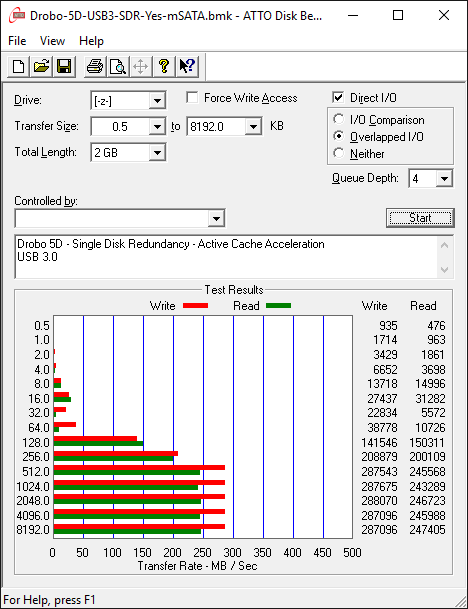
CrystalDiskMark, despite being a canned benchmark, provides a better estimate of the performance range with a selected set of numbers. In this case, we can see the sequential access numbers back up the ATTO results. Random access numbers are quite decent for a hard-drive array.
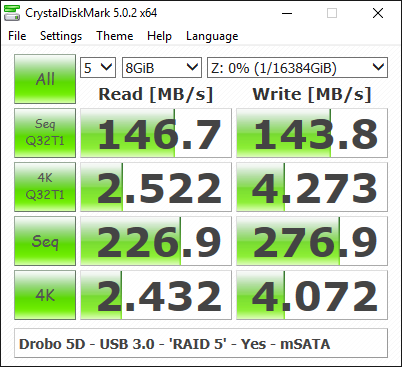
Benchmarks - robocopy and PCMark 8 Storage Bench
Our testing methodology for DAS units also takes into consideration the usual use-case for such devices. The most common usage scenario is transfer of large amounts of photos and videos to and from the unit. Devices like the Drobo 5D are often used to import files directly off the DAS into a multimedia editing program such as Adobe Photoshop.
In order to tackle the first use-case, we created three test folders with the following characteristics:
- Photos: 15.6 GB collection of 4320 photos (RAW as well as JPEGs) in 61 sub-folders
- Videos: 16.1 GB collection of 244 videos (MP4 as well as MOVs) in 6 sub-folders
- BR: 10.7 GB Blu-ray folder structure of the IDT Benchmark Blu-ray (the same that we use in our robocopy tests for NAS systems)






In all the above benchmarks, we see that the mSATA cache acceleration is not useful at all (we are testing out a one-time copy of data to and from the unit). The single-disk redundancy configuration consistently performs better than the dual-disk redundancy option.
For the second use-case, we take advantage of PC Mark 8's storage bench. The storage workload involves games as well as multimedia editing applications. The command line version allows us to cherry-pick storage traces to run on a target drive. We chose the following traces.
- Adobe Photoshop (Light)
- Adobe Photoshop (Heavy)
- Adobe After Effects
- Adobe Illustrator
Usually, PC Mark 8 reports time to complete the trace, but the detailed log report has the read and write bandwidth figures which we present in our performance graphs. Note that the bandwidth number reported in the results don't involve idle time compression. Results might appear low, but that is part of the workload characteristic.


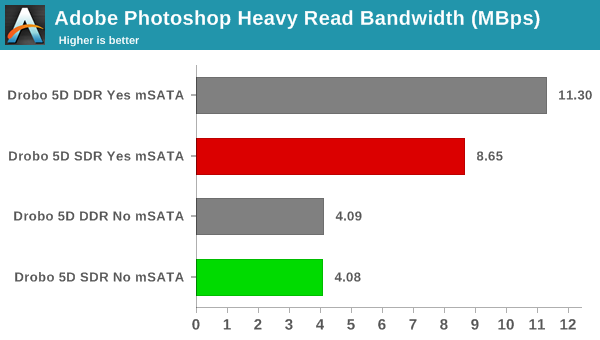

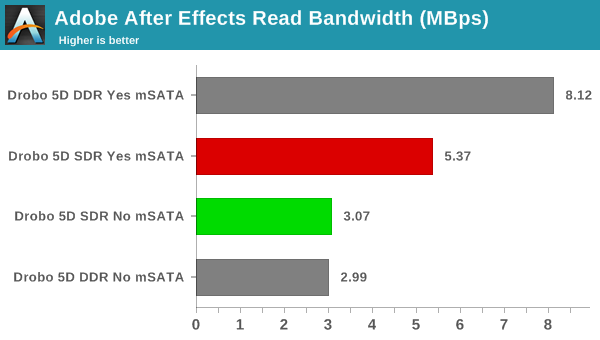

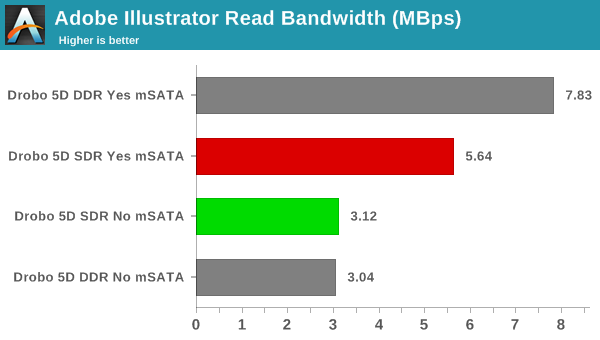

In the real-world work traces, we can see the real benefit of the mSATA SSD cache acceleration. Writes don't benefit much, but, in the read workloads, we can see that the mSATA SSD-enabled configurations often provide almost double the performance of a raw hard-drive array.










74 Comments
View All Comments
ImSpartacus - Monday, April 25, 2016 - link
Yeah, it's tough to swallow the cost. I've asked myself the exact same question with respect to drobo.bill.rookard - Monday, April 25, 2016 - link
Exactly. I have a full blown desktop, dropped in 3 Seagate ES 4TB disks into a IcyDock and am running a virtualized CentOS with raw disk access into a RAID5 array. Currently testing it for stability to make sure it's going to work right before taking down my standalone setup.ydeer - Monday, April 25, 2016 - link
In my experience:Lower latency than a GigE NAS and thus better performance in everyday usage
Significantly lower power consumption
Reliable standby and wakeup in sync with the connected Computer (unlike WOL)
Setup simplicity, almost zero configuration required, firmware updates are completely hands-off.
chekk - Monday, April 25, 2016 - link
Simple. Most people reading Anandtech are not in Drobo's target demographic.Readers here always compare it to some file server they set up themselves for low cost, but never factor in the many hours to learn all the hardware and software setup (e.g. learn ZFS) and then make it stable.
A unit like the Drobo removes the vast majority of those hours, but not for free.
It's not a bad or particularly expensive product, just not for you.
beginner99 - Monday, April 25, 2016 - link
It is still more expensive than a similar off the shelve NAS, which doesn't require much knowledge to set up. (not more than drobo). Plus with NAS you don't need a PC with Thunderbolt. But yeah. the target audience is people that need huge amounts of fast direct attached storage. It's a different use case than a NAS.BedfordTim - Monday, April 25, 2016 - link
Have you ever tried to get a broken NAS fixed? For a business losing you data for a week or more while you deal with the dreadful support offering from NAS vendors is a disaster. A PC based system allows you get up and running the next day.Spunjji - Tuesday, April 26, 2016 - link
That line of thinking works right up until you try to get support for your dead box 6 months outside of warranty. Then there is suddenly nothing user friendly about the device.jjunos - Monday, April 25, 2016 - link
Not much.If you are the type of users who is goign to build their own NAS, and have the technical know how, not much here is going to sell you. The only thing may be the dynamic way you can add space with additional HD's.
From a guy who owns 2 drobos and 2 synology's, the only benefit over that is easy of use, flexible expandibility, and the apps. Note though, drobo's apps are worse than the synology so if you are looking for an app, a good chance synology will have it, and the drobo will be a hassle
extide - Monday, April 25, 2016 - link
I guess for the average consumer -- it's the easy setup and stuff. To me, it makes zero sense. I run ZFS and manually manage it all, but that's just my preference. I would rather configure everything directly and stuff. Plus I am not dependant on any proprietary hardware. I can move my drives to any linux or solaris machine and get my data. I am also not relying on hardware raid, which would mean I am tied to that particular manufacturer's raid cards. Drobo could go out of business and then if your box failed you are pretty much SoL.jasonelmore - Monday, April 25, 2016 - link
Simplified Redundancy with Mixed Drives off the network. Mission critical data, Trade Secrets, Computer code that China would like to hack, etc... Kept off a network, even a local network is only as strong as it's weakest link.